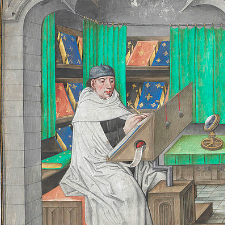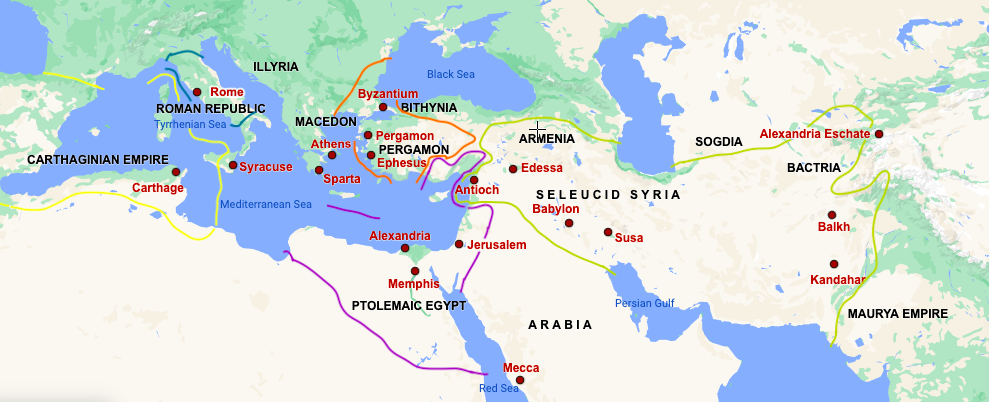Texts in Context:
Just What Was the Hellenistic Period?

By Gabriel Blanchard
It was, as Dickens put it, the best of times and the worst of times. At least, it was somebody's best of times, probably.
The Successors’ Wars
When Aristotle took his leave of us last week, Alexander the Great had been dead for a year (or a little less—the exact date of the former’s death does not seem to be known). If Alexander had had an obvious heir, things might have gone more smoothly. He did have a son by his Persian wife, but this son was not yet born when the conqueror died. He also had an elder half-brother, Philip III Arrhidæus, who had originally been passed over for the kingship due to simple-mindedness.1 One account suggests that one of his generals, Craterus, whom he had appointed his regent in Macedon, was meant to succeed him; others say the same thing about another general, Perdiccas. An old advisor, Antipater, had been sent for with fresh troops—he and Craterus were to switch places, more or less—but upon the upset, he formed a triumvirate with Craterus and Perdiccas, or at least that was how it was supposed to go …
The Successors’ Wars (also known, from the Greek term for “successor,” as the Wars of the Diadochi) are confusing, and tedious, and endlessly the same—petty, but not entertainingly so; bloodshed that is immense without feeling significant. The fighting went on until, around the year 301 BC, most of the remains of the empire had settled into some sort of order.2

Besides Macedon proper (now ruled by Alexander’s old schoolmate Cassander), there were three important successor states. One was Ptolemaic Egypt, which was the same in substance as the editions of Egypt known to the ancients, except that this time around, the pharaonic dynasty (a) was Greek in origin and language, and (b) would last more than a century, for variety’s sake. Second, there was the Kingdom of Pergamon, which occupied roughly the same territory as the old realm of Lydia. The third was Seleucid Syria, the largest post-Alexandrian remnant, and for some time the dominant one of the bunch. (Strikingly, Egypt and Syria not only played comparable roles to Egypt and Assyria in the Bronze Age, but even fought over the same stretch of turf: Palestine.)
The Meaning of Hellenistic
In all of these states, the culture of the elites was now Greek, blended to some degree with Persia’s. This may have been inspired partly by the policies of Alexander; but it is even likelier than this blending simply represented the “path of least resistance,” given the Achæmenids had controlled the Near East for the prior two hundred years.
This culture came to be known as “Hellenistic,” which you’ll notice is slightly off from the normal adjective Hellenic. That term refers to the Greek people themselves; Hellenistic embraces all those societies of the ancient world that came under Greek influence, from Ætna to the Zagros Mountains and beyond. We may take special note of five aspects of this period: the linguistic, the social, the intellectual, the artistic, and the religious.
1. Hellenistic Languages
Greek was now spoken from Spain to the India—though this does not mean all these regions exclusively spoke Greek. It wasn’t even the only prestige language. Latin and Etruscan were spoken in Italy; the Egyptian language had reached its Demotic form; and in most of the former Persian lands, Old Aramaic was as much a lingua franca as Greek.3 Additionally, the kind of Greek used at the time is not “classical Greek,” not strictly. It is instead a variety called Koiné Greek, marked by simplifications in grammar and vocabulary.
2. Hellenistic Society
We think of Greece as the cradle of democracy, and this is not entirely incorrect; but if anyone expected to see democracy spreading through Alexander, they will be disappointed. After all, self-governance was a chiefly Ionian value, not a pan-Hellenic one (cities like Corinth, Sparta, or Halicarnassus had no time for it4); and those Hellene values that had been spread abroad were taken there by a conquering emperor, which perhaps did little to encourage “barbarians” to take democracy seriously.
Other Greek institutions fared better abroad. Hellenic-style athletics and gymnasia were popular—less so to the east, where cultural taboos against nudity (the norm in Greek athletics) were strong, even in single-sex settings. The drachma, the base unit of currency in Greek city-states, also spread; it was common enough that the New Testament treats the drachma and the Roman denarius as interchangeable. But the main exports of Hellas were intellectual.
3. Hellenistic Academia
Hellenistic philosophy was arranged in various haireseis [αἵρεσεις] or “schools of thought.” There were many of these, but the important ones were the big three: Stoicism, Epicureanism, and Skepticism.
So came the twilight upon Arcady and the last notes of the pipe sound sadly from the beechen grove. In the great Virgilian poems there is already something of the sadness; but the loves and the household gods linger ...
G. K. Chesterton, The Everlasting Man, Part I, ch. 7: The End of the World
- The Stoics were named for the Painted Portico, or Stoa Poikilē [Στοά Ποικίλη], which was their original meeting place. They believed that virtue was not just the primary ingredient in happiness, but the only one, if a person could learn to accept what they could not control; they therefore focused on self-discipline, logic, and detachment.
- Second in place were the Epicureans. Epicurus did teach that pleasure is the source of happiness, which is why the modern meaning of Epicurean is “hedonist”; however, Epicurus asserted a nuanced, complex definition of pleasure, which led his school to advocate simple living, not self-indulgence.
- Finally, there were the Skeptics, of which there were two subtypes: the Pyrrhonists and the Academic Skeptics. The Pyrrhonists recommended reserving judgment on all debatable matters to achieve peace of mind; the Academics maintained, more severely, that nothing could be known at all. This latter subtype were named for their command of the Academy in Athens, starting about a century after Plato’s death.
As a center of learning, Athens, home of the Academy and the Lyceum, reigned supreme. But there were other cities joining her now: as in the height of the Bronze Age, every city of importance could be relied upon to possess at least a basic archive or a small temple to an appropriate god or gods. There were two related institutes of higher learning in Alexandria (the Egyptian one): the Serapeion, named for the newly-popular deity Serapis, was an offshoot of the older Mousaion, a temple to the Muses. (The Romans altered the names a little when writing in Latin, making them the Serapeum and the Musæum.) Alexandria was famed for its collection of books, and was the first place to produce a Greek translation of the Jews’ books about their God. Egypt being the native habitat of papyrus stood the city’s libraries and scholars in good stead. Around the same time, the city of Pergamon in Anatolia became such a renowned center for erudition, the term “parchment” (which succeeded papyrus thanks to its higher versatility5) is thought to be a corruption of the city’s name.
Speaking of parchment, during the Hellenistic age, the traditional form of books began to drop out. Instead of writing a book out on papyrus and then rolling it up, like a normal person, the latest crop of instant-gratification, inattentive brats came up with the codex.6 Sure, codices were easier to use than scrolls, but they looked ridiculous! It was as if someone chopped a papyrus roll up, scribbled all over both sides of the pieces (because apparently these children don’t know that ink bleeds), and then sewed them back together through one side—and when you point this out to them, if you please, they tell you that’s exactly what they did! This was obviously the death knell for literature.
4. Hellenistic Art
Speaking of literature, and of Greek institutions, the theater also did quite well abroad. New forms of drama and new playwrights emerged, notably out west in Rome, like Ennius, Plautus, and Terence. The more “physical” arts of sculpture and architecture also flourished. At the extreme eastern end of the former Alexandrian Empire, the Indo-Greek kingdoms of Bactria and Yavana fused Greek and Indian cultures in ways never seen before or since, notably producing beautiful Greco-Buddhist sculptures.
5. Hellenistic Religion
In this, we saw one of the most interesting shifts of the whole period—so much so that, in order to do it and its influence justice, we will leave it for next week.
1The general opinion of scholars is that Arrhidæus had a learning disability. Whether out of cynical concern that he could be used as a pawn (which did happen in the Successors’ Wars) or real affection, or both, Alexander had taken Arrhidæus with him into Asia.
2In Macedon and Greece proper, warfare continued for another quarter-century. It was finally quelled partly by the need for a united response to the ravages of a people the Greeks called Keltoi [Κελτοί]; they were raiding throughout the Hellene peninsula, and even immigrating into central Anatolia.
3This is a truly tiny selection of the then-current languages (we have ignored Hebrew and Persian, just to start). Etruscan, an isolate, was the language of the Etruscan civilization, one of the most influential societies on the Italian peninsula—Rome had an Etruscan dynasty during its monarchic period. Demotic was the third of four basic stages of the Egyptian language: Old, Classical, Demotic, and Coptic. (Coincidentally, the term lingua franca originally referred to a historical language, also called Sabir. It was based on various Romance dialects, mixed with Semitic and Turkic elements.)
4Halicarnassus, the hometown of Herodotus, seems especially to have resisted egalitarianism. A monarchy and under Achæmenid suzerainty, it was one of the few cities not to join the Ionian Revolt that precipitated the Græco-Persian War, and remained loyally Persian until Alexander conquered it.
5Papyrus was cheaper to manufacture, but the only place it was known to grow was the Nile; it also decayed rapidly in moist environments. Parchment, since it was made from animal skins, was in principle available anywhere and was easier to preserve.
6History does not relate whether scroll hard-liners always said the word “codex” while making air-quotes with their fingers, forcing us to presume that they did. The fact that quotation marks had not yet been invented goes to show you how creative human beings can be.
Gabriel Blanchard (who escaped having to partake in the Successors’ Wars by telling people he would live a few thousand years in the future) is CLT’s editor at large. He lives in Baltimore, MD.
If you liked this piece, and want to read more about the intellectual tradition that descends from the Mediterranean, you might also enjoy our profile of twentieth-century philosopher Edmund Husserl, our “Great Conversation” posts about the concept of faith, the idea of ideas, and scholarly authority, or our earlier Texts in Context post about the pre-Socratic philosophers.
Published on 5th August, 2024. Page image of Al Khazneh (“the Treasury”); this elaborate rock-cut tomb, dating to the first century AD, was hewn out of a cliff face by the Nabatean Kingdom, and is located in Petra (a city abandoned around the seventh century, now a flourishing archæological site and tourist attraction) in the southwest of Jordan. Photograph by Graham Racher, used under a CC BY-SA 2.0 license (source). Persons of the present writer’s generation may recognize it from its appearance in the film Indiana Jones and the Last Crusade, while those younger may associate it with Transformers: Revenge of the Fallen. Today’s map of the Mediterranean and southwestern Asia was created with the assistance of scribblemaps.com.